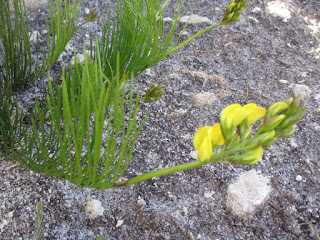They seem to be taller than the ones we remember from two years ago, before the big fire in this area.
We always see Lobelias, those with the bright blue large flowers we think is L. tomentosa:
Although most are past their best, there are still Agapanthus walshii in flower:
This one below had us excited, was it the elusive white one? No, but a very pale blue:
It was pleasing to check that this one had been logged, finding my present position exactly the same as one marked 'AW Lower Rocky Ridge'.
The deep blue of the Purple Powder Puff Pseudoselago serrata, after an impressive season, is nearly over.
There were even still a few flowers on occasional Psoralea pinnata:
Pinks, oranges and reds seemed to be the other colour of the day. Although many of these Watsonia schlechteri have gone to seed, there are still many in bud, so we'll be seeing them for a while yet.
Before the fire, we pinpointed what we thought were Erica obliqua. We have searched that location carefully since without success. About 100 metres away we have found a strong population, perhaps 20 plants so far, of what we hope is the same:
Welcome back!
Also pleasing to see in that vicinity, another old favourite (the Ericas seem to have recovered the slowest!) Erica pulchella:
We specially went back to look at a Protea-type which we've been watching for weeks now. Only one tiny flower opened in the middle of December, and we found it today, actually loose from the plant, but held in place by branches of new growth. We left it there, to mature fully and disperse seeds.
There are about eight plants in a small area. The closest we get to identifying it from the books is Leucospermum bolusii, but if it is, it's way out of its area, supposed to be the slopes above Gordon's Bay. The tips of the new growth are pinkish:
What can it be?
It's nice to see the Brachylaena neriifolia in flower again! The shrubs have a lot of growing to do to reach the size of some of those which were burnt!
It's always nice to go home past the Prickly Pear Opuntia in the garden of the ruins of the Railway Foreman's house:
:-) Andy



























































